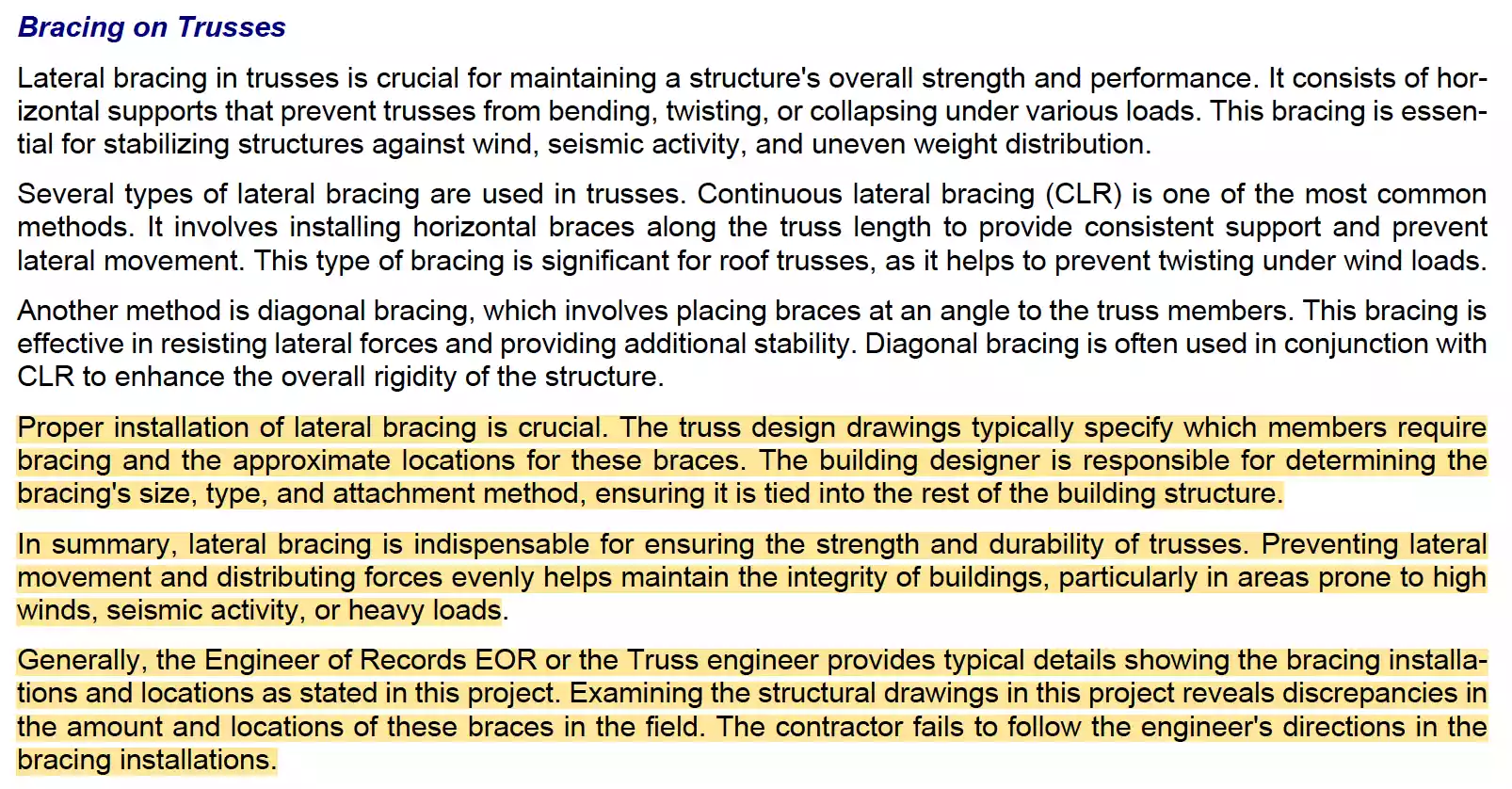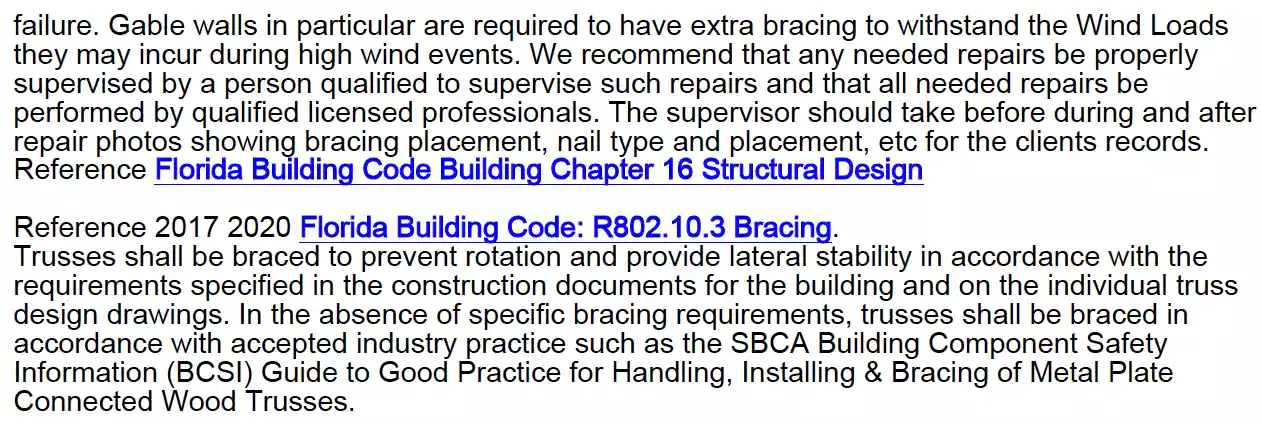In November 2024, we notified Neal Communities of a critical structural deficiency in our brand-new home:
Required lateral bracing in our roof truss system was missing.
Not misaligned.
Not substandard.
Missing.
We provided a detailed report from a licensed home inspector. When Neal Communities failed to act, we did what any responsible homeowner would do—we escalated. We hired a professional engineer to independently verify the findings, because once you learn that something as fundamental as lateral bracing is missing in the bones of your roof, you stop sleeping well.
Every creak.
Every gust of wind.
Every crack in the drywall.
It all makes you wonder: Is the structure safe?
Both the inspector and the engineer confirmed our worst fears: the trusses in our attic were not properly braced according to the Engineer of Record’s design—and in the home inspector’s professional opinion, this condition may not meet the requirements of the Florida Building Code.
And yet, to this day—five months later—Neal Communities has not sent an engineer.
Not a structural consultant.
Not even a written response to our Chapter 558 Notice, addressing our findings.
What Is Lateral Bracing—and Why Is It So Important?
In simple terms, lateral bracing is a system of wooden members that connect the trusses horizontally across your attic. It prevents the trusses from bowing, twisting, or collapsing under stress—like wind, weight, or time.
Think of a row of dominoes standing on edge—one push from the side, and they collapse. Lateral bracing is what prevents that from happening inside your roof.
Without it?
Trusses can deflect, crack, or fail entirely. The entire roof system becomes vulnerable—and in Florida, with our storms and humidity, that’s not just a problem. It’s a life safety issue.
What the Engineer Found


What Our Home Inspector Found


What does the Florida Building Code say?
Under Florida Building Code and ANSI/TPI 1 standards, roof trusses must be installed exactly according to the truss design drawings sealed by the Engineer of Record. Field deviations are not allowed unless approved in writing by a licensed engineer.


Why This Matters
This isn’t about drywall seams or chipped paint.
This is about the structural backbone of the home.
Lateral bracing is not optional. It’s an engineered requirement—clearly detailed in the sealed truss design documents, supported by building code, and critical to the long-term safety and stability of the structure.
When it’s missing, the risk isn’t cosmetic.
It’s structural failure under stress.
And the consequences can be severe—even catastrophic.
Roof trusses are designed to function as a unified system. Each truss depends on proper bracing to stay aligned, balanced, and structurally sound. Bracing provides lateral stability—it keeps the trusses from buckling, twisting, or shifting over time or under environmental pressure.
Without it, your trusses are vulnerable.
That vulnerability only increases with time, heat, humidity, and storm-related wind uplift. In Florida, that’s not just a concern—it’s a known risk.
When lateral bracing is missing, it can lead to:
- Structural deformation of the roof
- Trusses shifting, warping, or cracking
- Ceiling and drywall separation
- Structural stress during wind events
- And in worst-case scenarios: progressive structural collapse
Florida homes face extreme environmental stress. This is not a climate where structural shortcuts are safe—or acceptable.
And in this case, the bracing wasn’t just overlooked.
According to two licensed professionals, it was never installed.
We notified Neal Communities in November 2024, backed by expert findings from a licensed home inspector. We followed the proper legal process. We raised the issue clearly and formally.
It’s now April 2025.
No engineer has been sent.
No structural assessment has been performed.
No written explanation has been provided.
As homeowners, we did our part.
We raised the alarm.
We submitted a Chapter 558 Notice, as required by Florida law.
We asked for safety, clarity, and accountability.
And in return?
Here we are. Still in the exact same situation.
The Emotional Toll
There is no way to truly describe what it feels like to live inside a home that you no longer trust to protect you.
When we discovered that critical lateral bracing was missing in our roof structure—it changed everything.
What was supposed to be our dream home became a source of fear.
Every time the wind blows.
Every time the house creaks.
Every time we look at the ceiling and wonder, is today the day something gives?
That kind of fear doesn’t go away. It doesn’t get quieter with time. It gets louder. It gnaws at you in the quiet moments—the ones that are supposed to feel like home.
And through all of this, Neal Communities has done nothing.
This is not a small builder with limited resources. Neal Communities is a multimillion-dollar corporation, with architects, engineers, construction managers, and legal teams at its fingertips. When public pressure builds, they create “task forces.” They deploy “SWAT teams.” They send carefully worded emails to manage their image.
But when homeowners report a serious, documented structural defect?
Silence.
They didn’t send an engineer.
They didn’t inspect.
They didn’t even ask a question.
Just silence regarding our roof—for five months and counting.
We cannot understand how any responsible builder would knowingly allow homeowners to live like this. With this kind of risk. With this kind of fear.
And what makes it even worse—this isn’t even the worst issue we’ve found in our roof.
There’s more. And we’ll be sharing it shortly.
But this—this alone—is enough to rob a family of sleep, of peace, and of the most basic human expectation: to feel safe in your own home.
We’ve uncovered multiple structural issues—each confirmed by licensed professionals, each raising serious concerns about safety and oversight.
We’ll be sharing them all.
Because no family should be left to live under a roof full of questions.
And no homeowner should ever be left in that position.
And somehow, despite everything—we still are.

This post reflects our personal experience as homeowners and is based on findings documented by licensed professionals, including a certified home inspector and a professional structural engineer. All references to potential code violations or structural concerns are drawn from their expert opinions and reports. We have followed the legal process as outlined in Chapter 558 of the Florida Statutes and make no allegations of intentional misconduct or unlawful behavior by Neal Communities. Our goal is to raise awareness about the importance of structural safety and transparency in residential construction. Readers are encouraged to consult with qualified professionals for guidance on any construction-related issues in their own homes



Glad you went public. Sometimes it’s the only way to get people to do the right thing. I am sad and mad that you are going through this. It’s one thing for a builder to screw up. It’s another to dismiss what sounds like a clear building violation.